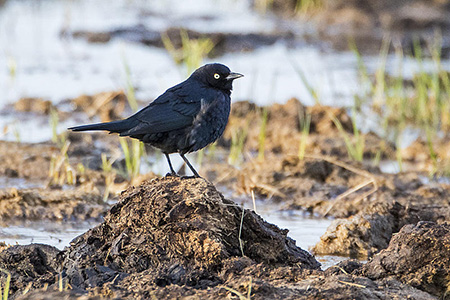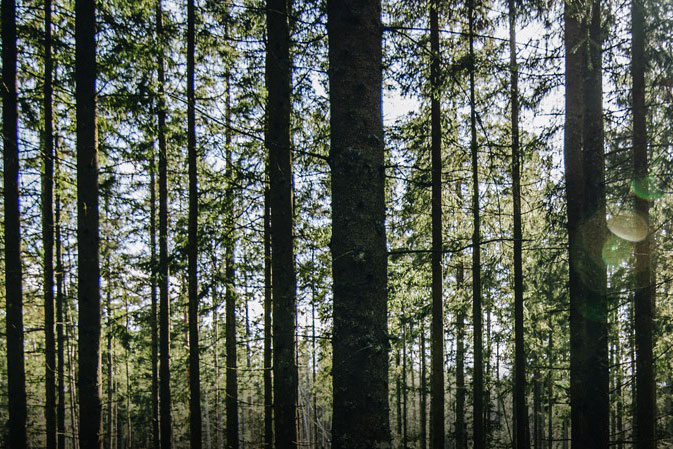The Rusty Blackbird breeds up to the northern tree line in Canada, farther north than any other North American Blackbird. Its nest is usually within 12m of water and is often reused by Solitary Sandpipers.
Rusty Blackbird
(Euphagus carolinus)
Habitat Ecology
- The Rusty Blackbird has a northern breeding range, where it is mainly found in wet coniferous forests (mainly black spruce and tamarack) near and along bogs, muskeg swamps, beaver ponds, and streams.1
- Nests are usually built in dense thickets of small conifers (e.g., 3–6 m black spruce with <8 cm dbh or 1–3 m balsam fir) or, where coniferous trees are limiting, deciduous shrubs (e.g., willow).2,3
- Nests are typically built within 12 m of water, on average.3
- Important habitat features for nest sites include shallow or vernal pools containing aquatic invertebrates and insects4 (including recently burned wetlands5).
- Stand age appears to be less important than the presence of short conifers, whether due to recent disturbance (e.g., harvest) or due to stunted growth on wet/low-productivity sites.6

Response to Forest Management
- Harvest effects in western forests are poorly understood for Rusty Blackbirds. While they have been observed in harvested stands containing residuals up to 30 years postharvest, sample sizes have been too low to conclusively infer a positive response to harvesting.7–9
- Some studies of reproductive success in New England suggest that harvested stands near coniferous wetlands may act as ecological traps, however results have been mixed and local studies are needed.
- In one study, Rusty Blackbirds preferentially nested in <20 year-old regenerating clearcuts than in unharvested stands. However, nests in harvested stands were less than half as likely to successfully fledge young than nests in unharvested areas.3
- In another study in the same region found that harvest history did not affect nest success, but rather that survival increased with increasing densities of trees ≤4 cm dbh around nests.10
Stand-level Recommendations
- Continuous, 75 m buffers are recommended around coniferous bogs, fens, and other wetlands suitable for Rusty Blackbirds.
- These buffers should provide nesting habitat and increase nest survival.3,11
- Voluntary buffering of, or retention patches anchored around, small or vernal pools is recommended, particularly if the surrounding vegetation contains short, small-diameter, dense conifers (black spruce, tamarack, or balsam fir).1,10
- Precommercial thinning of small-diameter conifers is discouraged in cutblocks adjacent to coniferous wetlands or streams, as the reduced cover will make Rusty Blackbird nests more vulnerable to predators.10
Landscape-level Recommendations
- The Rusty Blackbird’s primary breeding habitats are likely to be well-represented on the passive landbase, including shallow wetlands, bogs, muskeg, beaver ponds, and low-productivity wet coniferous stands. Areas with high proportions of these features within a 38-ha area (i.e., this species’ home range) are considered of highest value and, if possible, road-building and other disturbances should be avoided within them.10
- While there is some evidence that Rusty Blackbirds are drawn to harvest-origin early-seral habitats with dense regenerating conifers, research is needed in western forests to determine whether these habitats negatively impact nest success.3,10
References
- Avery, M. L. 2013. Rusty Blackbird (Euphagus carolinus), version 2.0. in The Birds of North America (Rodewald, P. G., ed.) Cornell Lab of Ornithology, Ithaca, New York, USA. Available online: https://doi.org/10.2173/bna.200
- Matsuoka, S. M. et al. 2010. Nesting Ecology of the Rusty Blackbird in Alaska and Canada. The Condor 112: 810–824. Available online: https://doi.org/10.1525/cond.2010.100149
- Powell, L. L., Hodgman, T. P., Glanz, W. E., Osenton, J. D. & Fisher, C. M. 2010. Nest-site selection and nest survival of the rusty blackbird: Does timber management adjacent to wetlands create ecological traps? The Condor 112: 800–809. Available online: http://www.bioone.org/doi/full/10.1525/cond.2010.100152
- Environment Canada. 2015. Management Plan for the Rusty Blackbird (Euphagus carolinus) in Canada. Species at Risk Act Management Plan Series. Environment Canada, Ottawa. iv + 26 pp.
- COSEWIC. 2006. COSEWIC Assessment and Status Report on the Rusty Blackbird Euphagus carolinus in Canada. Committee on the Status of Endangered Wildlife in Canada, Ottawa. vi + 28 pp. Available online: www.sararegistry.gc.ca/status/status_e.cfm
- Powell, L. L., Hodgman, T. P., Fiske, I. J. & Glanz, W. E. 2014. Habitat occupancy of Rusty Blackbirds ( Euphagus carolinus ) breeding in northern New England, USA. The Condor 116: 122–133. Available online: https://doi.org/10.1650/CONDOR-13-033-R1.1
- Schieck, J., Stuart-Smith, K. & Norton, M. 2000. Bird communities are affected by amount and dispersion of vegetation retained in mixedwood boreal forest harvest areas. Forest Ecology and Management 126: 239–254.
- Schieck, J. & Song, S. J. 2006. Changes in bird communities throughout succession following fire and harvest in boreal forests of western North America: literature review and meta-analyses. Canadian Journal of Forest Research 36: 1299–1318. Available online: https://doi.org/10.1139/x06-017
- Hobson, K. A. & Schieck, J. 1999. Changes in bird communities in boreal mixedwood forest: Harvest and wildfire effects over 30 years. Ecological Applications 9: 849–863.
- Luepold, S. H. B., Hodgman, T. P., McNulty, S. A., Cohen, J. & Foss, C. R. 2015. Habitat selection, nest survival, and nest predators of Rusty Blackbirds in northern New England, USA. The Condor 117: 609–623. Available online: http://www.bioone.org/doi/10.1650/CONDOR-14-215.1
- Powell, L. L., Hodgman, T. P. & Glanz, W. E. 2010. Home ranges of rusty blackbirds breeding in wetlands: How much would buffers from timber harvest protect habitat? The Condor 112: 834–840.








